AUDI A4 AVANT 2008 Owners Manual
Manufacturer: AUDI, Model Year: 2008, Model line: A4 AVANT, Model: AUDI A4 AVANT 2008Pages: 368, PDF Size: 46.19 MB
Page 211 of 368

__________________________________________________ A_ i_ r _b _a-' g=- s_ y=-- s_t _e _m ______ lJfflll
& WARNING (continued)
expansion range of a SIDEGUARD head airbag can dangerously
interfere with its function. A deploying head airbag develops
enough force to catapult any piece of add-on component out of its
path of inflation and into the passenger compartment. An occu
pant hit by such a projectile can suffer serious injury or death
=> page 349, "Technical Modifications".
• Do not swivel the sun visors to the side if you have any objects
clipped onto them (for example
pens!. If the airbag should deploy,
you could be injured by these objects.
• Use the built-in coat hooks only for lightweight clothing. Never
leave any heavy or sharp-edged objects in the pockets that may
interfere with airbag deployment and can cause personal injury in
an accident.
• Never use hangers to hang clothing from the hooks.
• Only use factory-installed sun shades or, in the case of shades
installed after the vehicle leaves the factory, only Audi roll-up
sunscreens may be used => page 348, "Additional accessories and
parts replacement".
• Always sit in proper seating position and wear safety belts
while traveling so that the side curtain airbags can help provide protection .
• The airbag system can only be triggered once. If the airbag has
been triggered, the system must be replaced by an authorized
Audi dealer or qualified workshop.
• Always have work involving the side curtain airbag system,
removal and installation of the airbag components, or other
repairs performed by a qualified dealership. Otherwise the airbag
system may not work correctly.
• Never attempt to modify any components of the airbag system
in any way. •
Controls and equip ment Safety first
Vehicle operation Vehicle care Do-it-yourself service Technical data
Page 212 of 368
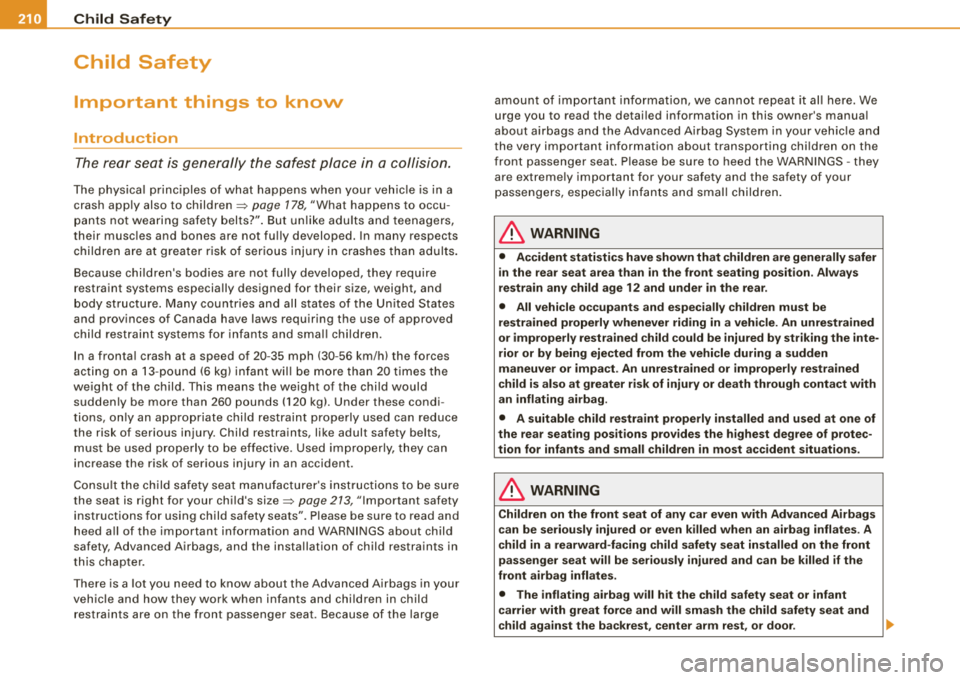
___ C_h_ i_ld _ S_ a_ f_ e_ t--= y'-------------------------------------------------
Child Safety
Important things to know
Introduction
The rear sea t is generally the safest place in a collision.
The physica l princ iples of what happe ns w hen your ve hicle is in a
crash app ly also to children
=> page 178, "What happens to occu
p a nts no t wearing safe ty belts?" . But un lik e adu lts and teenagers,
their musc les and bones are not fu lly developed. In many respects
children are at greate r risk of ser ious injury in cras hes than adul ts .
Because c hildren 's bodies are not ful ly deve loped, they require
restraint systems esp ecially designed for their size, weight, and
body st ructure. Many countr ies a nd al l states of the U nited States
and provinces of Canada have laws requiring the use of approved
ch ild restrai nt sys te m s for infant s and smal l chil dren.
I n a fronta l crash at a speed of 20 -35 mph (30 -56 km/h) the forces
ac tin g on a 13 -p o un d (6 kg) infant wil l be m ore tha n 20 times the
weight of t he child . T his means the weight of the c hild would
suddenly be more than 260 pounds (120 kg). Under these condi
tions, on ly an appropriate child restraint properly used can reduce
the risk of serious injury. Child restraints, like adult safety belts,
m ust be use d properly t o be eff ec tive. Use d imp ro perly, they ca n
increase the risk of serious injury in an accident .
Co nsu lt t he c hild sa fe ty seat manu fac ture r's ins truc tions to be su re
the seat is r ight for your child's
size=> page 213, "Important safety
instructions for using child safety seats" . Please be sure to read and
heed a ll of the important information and WARN INGS about child
safety , Advanced Airbags, and the installation of child restraints in
th is chapter.
T here is a lot you need to know about the Advanced Airbags in your
ve hicle and how they work whe n infan ts and c hildr en in child
restra ints are on the front passenger seat . Because of the large a
m ount of i mportant in formation, we cannot repeat it a ll here. We
urge you to read the detai led information in this owner's manua l
about a irbags and the Advanced Airba g Sys te m in your ve hicle an d
the very i mportant information about transporting chi ldren on the
fr on t passe nger seat . P lease be su re to hee d t he WAR NINGS
-they
are extreme ly important for your safety and the safety of your
p assengers, es pec ial ly in fa nt s and s mall chil dren .
& WARNING
• Accident statistics have shown that children are generally safer
in the rear seat area than in the front seat ing position. Always
restrain any child age 12 and under in the rear.
• All vehicle o ccupants and especially children must be
restrained properly whenever riding in a vehicle . An unrestrained
or improperly restrained child could be injured by striking the inte
rior or by being ejected from the vehicle during a sudden
maneuver or impa ct. An unrestrained or improperly restrained
child is also at greater risk of injury or death through contact with
an inflating airbag .
• A suitable child restraint properly installed and used at one of
the rear seating positions prov ides the highest degree of protec
tion for infants and small children in most accident situations.
& WARNING
Children on the front se at of any car even with Advanced Airbags
can be seriously injured or even killed when an airbag inflates . A
child in a rearward -fa cing child safety seat in stalled on the front
passenger seat will be seriously injured and can be killed if the
front airbag inflates .
• The inflating airbag will hit the child safety seat or infant
carrier with great force and will smash the child safety seat and
c hild against the backrest , center arm rest , or door . ..,_
Page 213 of 368

& WARNING (conti nued )
• Alw ays install r ear-facing child saf ety s eats on the r ear seat.
• If you mu st in sta ll a re arwa rd f acing child safe ty s eat on the
front pas senger seat in exc eptional cir cum stances and the
PASSENGER AIR BAG OFF light doe s not come on and stay on,
immediat ely install th e rear-fa cing child safety s eat in a rear
s e ating po sit ion and h ave the airb ag sys tem in spe cted immedi
a tel y by y our Audi dealer .
& WARNING
If, in exceptional circum stance s, you must in stall a forward -fac ing
c hild re st ra int on the fr ont p assenge r's s eat:
• Alway s make sure the forward -facing seat ha s been de signed
and cert ified by it s m anuf acturer for u se on a front se at with a
pa ssenger front and side airbag .
• Always follow the m anufacturer's instruct ions provided w ith
the child safet y seat or c arrier.
• Alway s m ov e th e passeng er sea t into it s re arm ost p osit ion in
the seat' s fore and aft adju stment range , as far away from the
a irb ag as possible before installin g the ch ild r estr aint . The b ack
rest must be adjusted to an upright po sition.
• Alway s ma ke sure th at the PASSENGER AIR BAG OFF light
come s on and stay s on all the time wheneve r the ignition i s
s wit ched on . •
Advanced front airbag system and children
Your vehicle is equipped with a dual -stage front "Advanced Airbag
System" in comp liance with United States Federal Motor Vehicle
Safety Standard ( FMVSS) 208 as applicab le at the time your vehic le
was manufactured .
Controls and equip
ment Safety first Vehicle operation
Chi
ld Sa fe ty
The Advanced Airbag system in your vehic le has been certified to
meet the " low -risk" require ments for 3 and 6 yea r- old c hild ren on
the passenger side and small adu lts on the driver side . The low risk
deployment c rite ria are intended to reduce the risk of inju ry th rough
interaction with the airbag that can occur, for example, by being too
close to the steering whee l and instrument panel when the airbag
in flates . In add it ion, the system has been cert ified to comply with
the "suppression" requirements of the Safety Standard, to turn off
the front airbag for in fants up to 12 months who are restrained on
the front passeng er seat in child restraints that are listed in the
Standard.
Even though your vehic le is equipped with an Advanced Airbag
system, all ch ildren, especially those 12 years and younger, sho uld
a lways ride in the back seat proper ly restra ined for the ir age and
size . The airbag on the passenger side makes the front seat a poten
tially dangerous p lace for a chi ld to r ide. The front seat is not the
safest p lace for a chi ld in a forward -facing child safety seat. It can be
a very dangerous place for an infant or a larger chi ld in a rearward
facing seat. •
Advanced Airbags and the weight-sensing
mat in the front seat
The Advanced A irbag System in your ve hicle detects the p resence
of an infant or chi ld in a child restraint on the front passenger seat
using the weight -sensing mat in the seat cushion and the sensor
below the safety belt latch on the front passenger seat that
measures the tension on the safety belt .
The weight -sensing mat meas ures total we ig ht of the ch ild and the
child safety seat and a chi ld blanket on the front passenger seat. The
weight o n the fr ont passenge r seat is related to the desig n of the
child restraint and its "footprint" , the size and shape of the bottom
of the child restraint as it sits on the seat. The weight of a child
restraint and its "footprint" vary for different kinds of chi ld
_..
Vehicle care Do-it-yourself service Technical data
Page 214 of 368

___ C_ h_il _
d _S __ a;;.;. f;..; e ;..;t ;,!,.y _________________________________________ _
restraints and for the different models of the same kind of child
restraint offered by child restraint manufacturers.
The weight ranges for the individual types, makes and models of child restraints that the NHTSA has specified in the Safety Standard
together with the weight ranges of typical infants and typical 1 year
old child have been stored in the control unit of the Advanced
Airbag System. When a child restraint is being used on the front passenger seat with a typical 1 year-old child, the Advanced Airbag
System compares the weight measured by the weight sensing mat
with the information stored in the electronic control unit.
The electronic control unit also registers the tension on the front
passenger safety belt. The tension on the safety belt for the front
passenger seat will be different for an adult who is properly using
the safety belt as compared to the tension on the belt when it is
used to attach a child restraint to the seat. The sensor below the
latch for the safety belt for the front seat passenger measures the
tension on the belt . The input from this sensor is then used with the
weight to "decide", whether there is a child restraint with a typical 1
year-old child on the front passenger seat and whether or not the airbag must be turned off.•
Child restraints and Advanced Airbags
Regardless of the child restraint that you use, make sure that it has
been certified to meet United States Federal Motor Vehicle Safety
Standards and has been certified by its manufacturer for use with
an airbag. Always be sure that the child restraint is properly
installed at one of the rear seating positions. If in exceptional
circumstances you must use it on the front passenger seat, carefully read all of the information on child safety and Advanced Airbags
and heed all of the applicable WARNINGS. Make certain that the
child restraint is correctly recognized by the weight -sensing mat
inside the front passenger seat, that the front passenger airbag is
turned off and that the airbag status is always correctly signaled by
the
PASSENGER AIR BAG OFF light. Many types and models of child restraints have been available over
the years, new models are introduced regularly incorporating new
and improved designs and older models are taken out of produc
tion. Child restraints are not standardized. Child restraints of the
same type typically have different weights and sizes and different
'footprints,' the size and shape of the bottom of the child restraint
that sits on the seat, when they are installed on a vehicle seat. These
differences make it virtually impossible to certify compliance with
the requirements for advanced airbags with each and every child restraint that has ever been sold in the past or will be sold over the
course of the useful life of your vehicle.
For this reason, the United States National Highway Traffic Safety
Administration has published a list of specific type, makes and
models of child restraints that must be used to certify compliance
of the Advanced Airbag System in your vehicle with the suppression
requirements of Federal Motor Vehicle Safety Standard 208. These
child restraints are:
A. Car beds, manufactured on or after September 1,
2004:
• Cosco Dream Ride 02-719
B. Rear facing child restraint systems, manufactured
on or after September 1, 2004:
(When the restraint system comes equipped with a removable base,
compliance has to be certified with or without the base).
• Britax Handle with Care 191
• Century Assura 4553
• Century Smart Fit 4543
• Cosco Arriva 02727
• Evenflo Discovery Adjust Right 212
• Evenflo First Choice 204
• Graco Infant 8457
Page 215 of 368
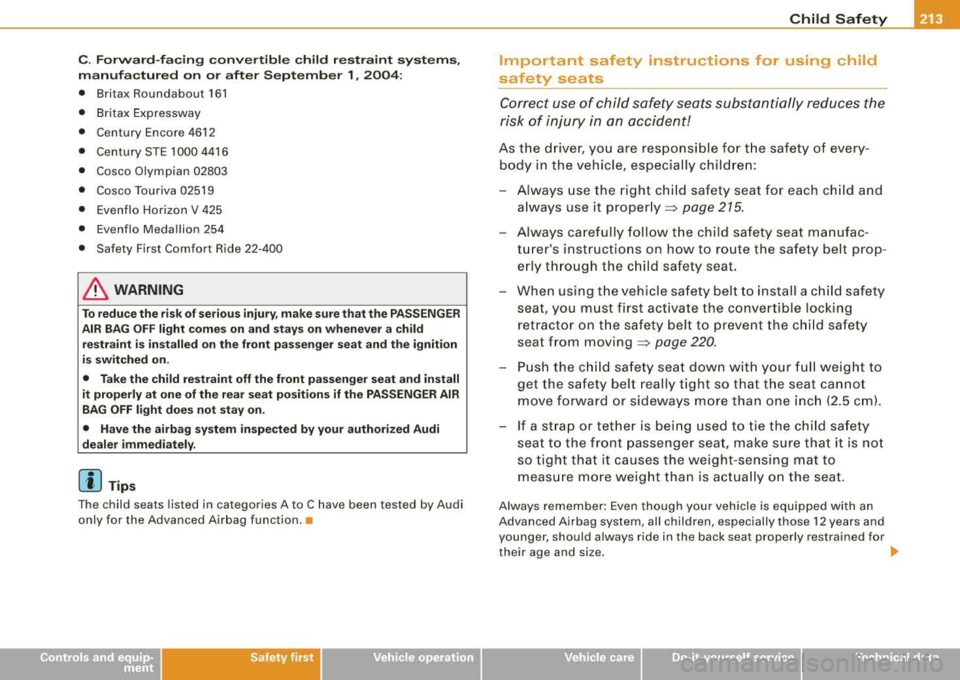
Child Safety -
---------------''------'
C. Forward-facing convertible child restraint systems,
manufactured on or after September 1, 2004:
• Britax Roundabo ut 161
• Brit ax Expressway
• Century Encor e 4612
• Century STE 1000 4416
• Cosco Olympian 02803
• Cosco Touriva 02519
• Evenflo Horizon V 425
• Evenflo M edallion 254
• Safety First Comfor t Ride 22-400
& WARNING
To reduce the risk of serious injury, make sure that the PASSENGER
AIR BAG OFF light comes on and stays on whenever a child restraint is installed on the front passenger seat and the ignition
is switched on.
• Take the child restraint off the front passenger seat and install
it properly at one of the rear seat positions if the PASSENGER AIR
BAG OFF light does not stay on.
• Have the airbag system inspected by your authorized Audi
dealer immediately.
[ i] Tips
Th e child s eats lis ted in cat egori es A to C have been tes ted by Audi
only for the Advanced Airbag function. •
Controls and equip
ment Safety first Vehicle operation
Important safety instructions for using child
safety seats
Correct use of child safety seats substantially reduces the
risk of injury in an accident!
As the driver, you are responsible for the safety of every
body in the vehicle, especially children:
- Always use the right child safety seat for each child and
always use it properly :::>
page 215.
-Always carefully follow the child safety seat manufac
turer's instructions on how to route the safety belt prop
erly through the child safety seat.
- When using the vehicle safety belt to install a child safety
seat , you must first activate the convertible locking
retractor on the safety belt to prevent the child safety
seat from
moving => page 220.
- Push the child safety seat down with your full weight to
get the safety belt really tight so that the seat cannot
move forward or sideways more than one inch (2.5 cm).
- If a strap or tether is being used to tie the child safety
seat to the front passenger seat, make sure that it is not
so tight that it causes the weight-sensing mat to
measure more weight than is actually on the seat.
Always remember: Even though your vehicle is equipped with an
Advanced Airbag system, all children, especially those 12 years and
younger, should always ride in the back seat properly restrained for
their age and size .
..,_
Vehicle care Do-it-yourself service Technical data
Page 216 of 368
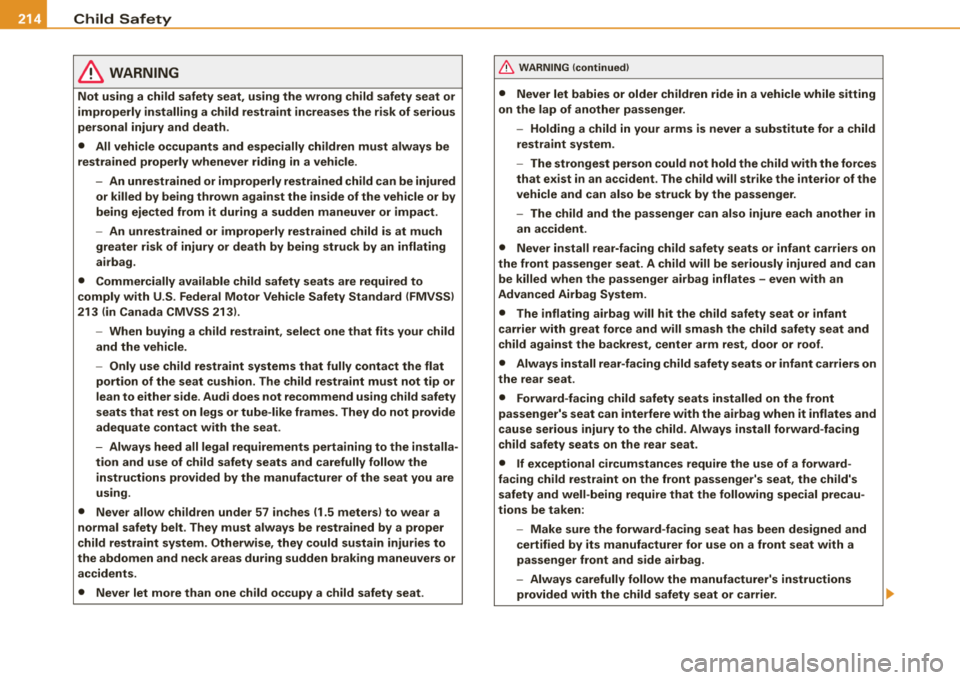
___ C_h_ i_ld _ S_ a_ f_ e_ t--= y'-------------------------------------------------
& WARNING
Not using a child safety seat, using the wrong child safety seat or
improperly installing a child restraint increases the risk of serious
personal injury and death .
• All vehicle occupants and especially children must always be
restrained properly whenever riding in a vehicle .
- An unrestrained or improperly restrained child can be injured or killed by being thrown against the inside of the vehicle or by
being ejected from it during a sudden maneuver or impact.
- An unrestrained or improperly restrained child is at much
greater risk of injury or death by being struck by an inflating
airbag.
• Commercially available child safety seats are required to
comply with U.S. Federal Motor Vehicle Safety Standard (FMVSSI
213 (in Canada CMVSS 2131.
-When buying a child restraint, select one that fits your child
and the vehicle.
- Only use child restraint systems that fully contact the flat
portion of the seat cushion. The child restraint must not tip or
lean to either side . Audi does not recommend using child safety
seats that rest on legs or tube-like frames. They do not provide
adequate contact with the seat .
- Always heed all legal requirements pertaining to the installa
tion and use of child safety seats and carefully follow the
instructions provided by the manufacturer of the seat you are
using.
• Never allow children under 57 inches (1.5 meters) to wear a
normal safety belt. They must always be restrained by a proper
child restraint system. Otherwise, they could sustain injuries to
the abdomen and neck areas during sudden braking maneuvers or
accidents.
• Never let more than one child occupy a child safety seat .
& WARNING (continued)
• Never let babies or older children ride in a vehicle while sitting
on the lap of another passenger .
- Holding a child in your arms is never a substitute for a child
restraint system .
- The strongest person could not hold the child with the forces
that exist in an accident. The child will strike the interior of the
vehicle and can also be struck by the passenger.
- The child and the passenger can also injure each another in
an accident.
• Never install rear-facing child safety seats or infant carriers on
the front passenger seat. A child will be seriously injured and can be killed when the passenger airbag inflates - even with an
Advanced Airbag System.
• The inflating airbag will hit the child safety seat or infant
carrier with great force and will smash the child safety seat and
child against the backrest, center arm rest, door or roof .
• Always install rear -facing child safety seats or infant carriers on
the rear seat .
• Forward-facing child safety seats installed on the front
passenger's seat can interfere with the airbag when it inflates and
cause serious injury to the child. Always install forward-facing
child safety seats on the rear seat.
• If exceptional circumstances require the use of a forward
facing child restraint on the front passenger's
seat, the child's
safety and well -being require that the following special precau
tions be taken :
- Make sure the forward-facing seat has been designed and certified by its manufacturer for use on a front seat with a
passenger front and side airbag.
- Always carefully follow the manufacturer's instructions
provided with the child safety seat or carrier.
Page 217 of 368
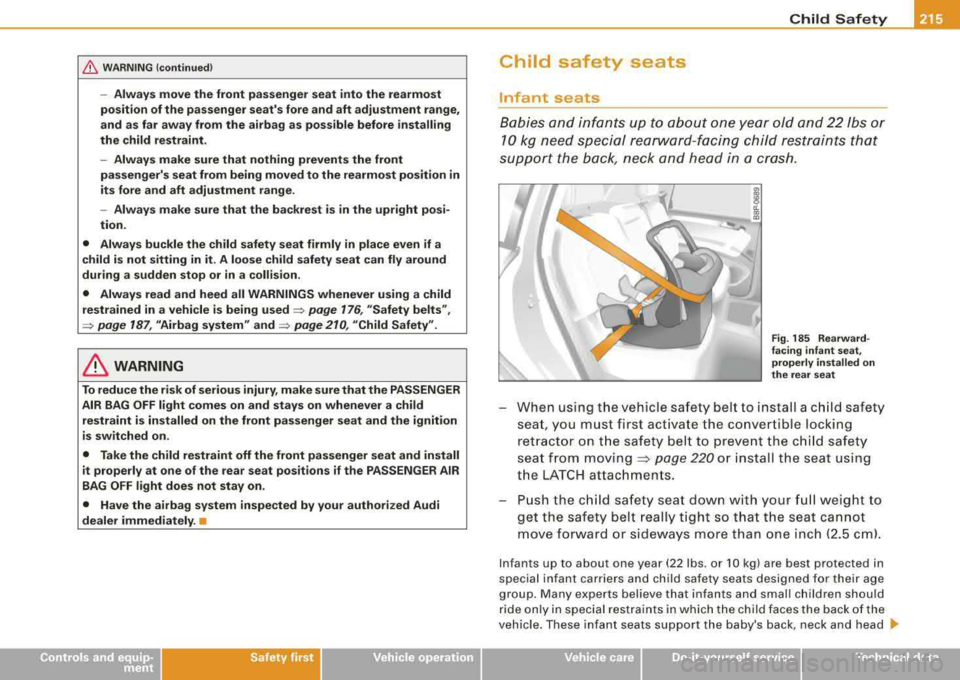
/b, WARNING (continued)
-Always move the front passenger seat into the rearmost
position of the passenger seat's fore and aft adjustment range,
and as far away from the airbag as possible before installing
the child restraint.
- Always make sure that nothing prevents the front
passenger's seat from being moved to the rearmost position in
its fore and aft adjustment range.
- Always make sure that the backrest is in the upright posi
tion.
• Always buckle the child safety seat firmly
in place even if a
child is not sitting in it. A loose child safety seat can fly around
during a sudden stop or in a collision.
• Always read and heed all WARNINGS whenever using a child
restrained in a vehicle is being
used=> page 176, "Safety belts",
=> page 187, "Airbag system" and=> page 210, "Child Safety".
& WARNING
To reduce the risk of serious injury, make sure that the PASSENGER
AIR BAG OFF light comes on and stays on whenever a child
restraint is installed on the front passenger seat and the ignition
is switched on.
• Take the child restraint off the front passenger seat and install
it properly at one of the rear seat positions if the PASSENGER AIR
BAG OFF light does not stay on.
• Have the airbag system inspected by your authorized Audi
dealer immediately. •
Safety first
Child Safety
Child safety seats
Infant seats
Babies and infants up to about one year old and 22 lbs or
10 kg need special rearward-facing child restraints that
support the back, neck and head in a crash.
I a. C0 a,
Fig . 185 Rearward
facing infant seat,
properly installed on
the rear seat
- When using the vehicle safety belt to install a child safety
seat, you must first activate the convertible locking retractor on the safety belt to prevent the child safety
seat from
moving~ page 220 or install the seat using
the LATCH attachments.
-Push the child safety seat down with your full weight to
get the safety belt really tight so that the seat cannot
move forward or sideways more than one inch (2.5 cml.
Infants up to about one year (22 lbs . or 10 kg) are best protected in
special infant carriers and child safety seats designed for their age
group. Many experts believe that infants and small children should
ride only in special restraints in which the child faces the back of the
vehicle. These infant seats support the baby's back, neck and head
.,_
irechnical data
Page 218 of 368
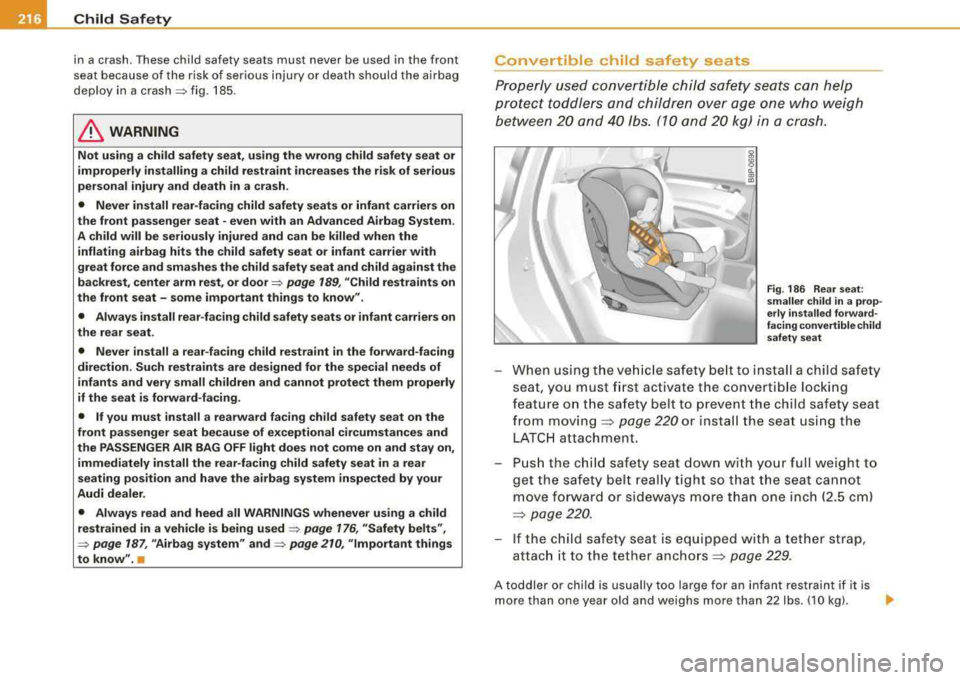
___ C_h_ i_ld _ S_ a_ f_ e_ t__, y'-------------------------------------------------
in a crash. These child safety seats must never be used in the front
seat because of the risk of serious injury or death should the airbag
deploy in a
crash:::::, fig . 185.
& WARNING
Not using a child safety seat, using the wrong child safety seat or
improperly installing a child restraint increases the risk of serious
personal injury and death in a crash.
• Never install rear-facing child safety seats or infant carriers on
the front passenger seat -even with an Advanced Airbag System.
A child will be seriously injured and can be killed when the inflating airbag hits the child safety seat or infant carrier with
great force and smashes the child safety seat and child against the
backrest, center arm rest, or
door:::::, page 189, "Child restraints on
the front seat
-some important things to know".
• Always install rear-facing child safety seats or infant carriers on
the rear seat.
• Never install a rear-facing child restraint
in the forward-facing
direction. Such restraints are designed for the special needs of
infants and very small children and cannot protect them properly
if the seat is forward-facing.
• If you must install a rearward facing
child safety seat on the
front passenger seat because of exceptional circumstances and
the PASSENGER AIR BAG OFF light does not come on and stay on,
immediately install the rear-facing child safety seat in a rear
seating position and have the airbag system inspected by your
Audi dealer.
• Always read and heed all WARNINGS whenever using a child
restrained in a vehicle is being
used :::::, page 176, "Safety belts",
:::::, page 187, "Airbag system" and:::::, page 210, "Important things
to know". •
Convertible child safety seats
Properly used convertible child safety seats can help
protect toddlers and children over age one who weigh
between 20 and 40 lbs. (10 and 20 kg) in a crash.
I d.. a, a,
Fig. 186 Rear seat:
smaller child in a prop·
erly installed forward·
facing convertible chi Id
safety seat
-When using the vehicle safety belt to install a child safety
seat, you must first activate the convertible locking
feature on the safety belt to prevent the child safety seat
from
moving ~ page 220 or install the seat using the
LATCH attachment.
-Push the child safety seat down with your full weight to
get the safety belt really tight so that the seat cannot
move forward or sideways more than one inch (2.5 cm)
~ page 220.
-If the child safety seat is equipped with a tether strap ,
attach it to the tether
anchors ~ page 229.
A toddler or child is usually too large for an infant restraint if it is
more than one year old and weighs more than 22 lbs. (10 kgl.
..,
Page 219 of 368
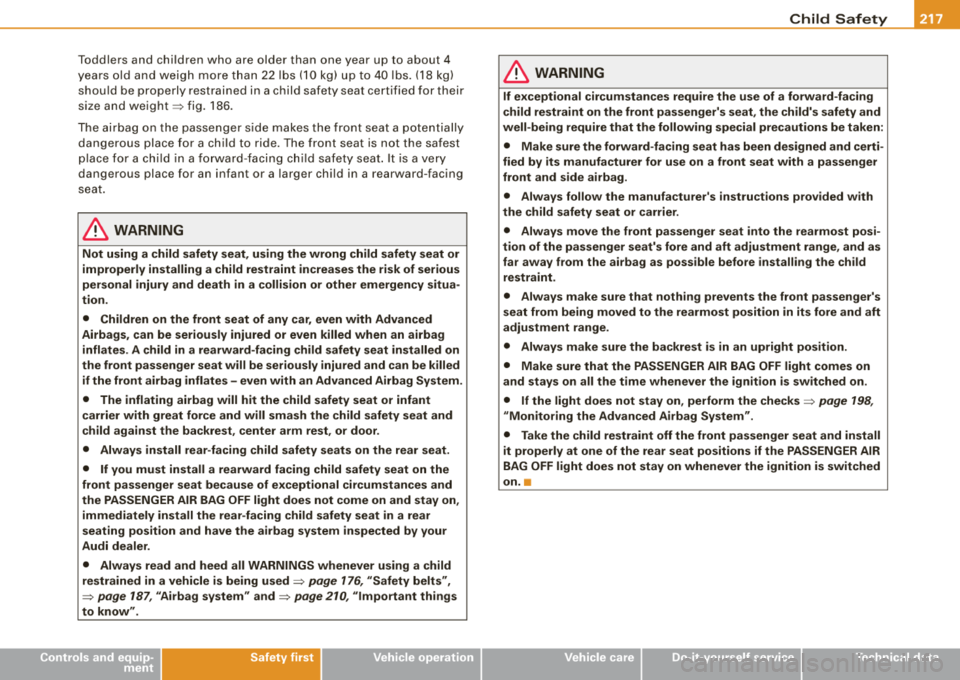
Child Safety -
---------------''------'
Toddle rs and chi ldren who ar e older than one y ear up to about 4
ye ars old and wei gh m ore th an 2 2 lbs (1 0 kg) u p to 40 lbs. (1 8 kg)
shou ld be prope rly restrained in a c hild saf ety s eat c ertifi ed for their
si ze and we igh t=> fig. 18 6.
T he a irba g on t he passe nger s id e m akes t he fr ont seat a p otentially
dangerou s place fo r a child to ride. The front seat is not the safest
pl ace fo r a c hild in a forw ard -f ac ing child safety sea t. It is a very
dangerous place for an infant o r a larger ch ild in a rearward-facing
s e at .
& WARNING
Not using a child safety seat, using the wrong child safety seat or
improperly installing a child restraint increases the risk of serious
personal injury and death in a collision or other emergency situa
tion .
• Children on the front seat of any car, even with Advanced
Airbags, can be seriously injured or even killed when an airbag inflates . A child in a rearward-facing child safety seat installed on
the front passenger seat will be seriously injured and can be killed
if the front airbag inflates - even with an Advanced Airbag System .
• The inflating airbag will hit the child safety seat or infant
carrier with great force and will smash the child safety seat and
child against the backrest, center arm rest, or door.
• Always install rear -facing child safety seats on the rear seat.
• If you must install a rearward facing child safety seat on the
front passenger seat because of exceptional circumstances and
the PASSENGER AIR BAG
OFF light does not come on and stay on ,
immediately install the rear -facing child safety seat in a rear
seating position and have the airbag system inspected by your
Audi dealer .
• Always read and heed all WARNINGS whenever using a child
restrained in a vehicle is being used => page 176, "Safety
belts" ,
=> page 187, "Airbag system " and => page 210, "Important things
to know".
Controls and equip ment Safety first
Vehicle operation
& WARNING
If exceptional circumstances require the use of a forward -facing
child restraint on the front passenger's seat , the child's safety and
well -being require that the following special precautions be taken:
• Make sure the forward -facing seat has been designed and certi
fied by its manufa cturer for use on a front seat with a passenger
front and side airbag.
• Always follow the manufacturer's instructions provided with
the child safety seat or carrier.
• Always move the front passenger seat into the rearmost posi
tion of the passenger seat's fore and aft adjustment range , and as
far away from the airbag as possible before installing the child
restraint.
• Always make sure that nothing prevents the front passenger's
seat from being moved to the rearmost position in its fore and aft
adjustment range .
• Always make sure the backrest is in an upright position .
• Make sure that the PASSENGER AIR BAG
OFF light comes on
and stays on all the time whenever the ignition is switched on.
• If the light does not stay on , perform the
checks => page 198,
" Monitoring the Advanced Airbag System ".
• Take the child restraint off the front passenger seat and install
it properly at one of the rear seat positions if the PASSENGER AIR
BAG
OFF light does not stay on whenever the ignition is switched
on .•
Vehicle care Do-it-yourself service Technical data
Page 220 of 368
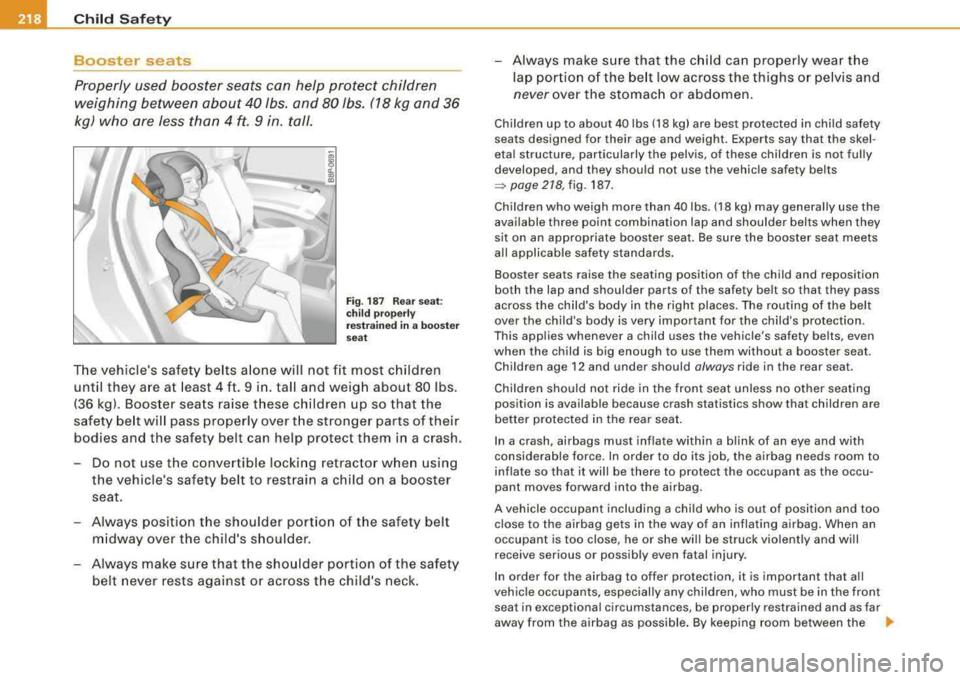
___ C_h_ i_ld _ S_ a_ f_ e_ t--= y'-------------------------------------------------
Booster seats
Properly used booster seats can help protect children
weighing between about 40 lbs. and 80 lbs. (18 kg and 36
kg) who are less than 4
ft. 9 in. tall.
Fig. 187 Rear seat:
child properly
restrained in a booster
seat
The vehicle's safety belts alone will not fit most children
until they are at least 4 ft. 9 in. tall and weigh about 80 lbs.
(36 kgl. Booster seats raise these children up so that the
safety belt will pass properly over the stronger parts of their
bodies and the safety belt can help protect them in a crash.
-Do not use the convertible locking retractor when using
the vehicle's safety belt to restrain a child on a booster seat.
-Always position the shoulder portion of the safety belt midway over the child's shoulder.
-Always make sure that the shoulder portion of the safety
belt never rests against or across the child's neck.
-Always make sure that the child can properly wear the
lap portion of the belt low across the thighs or pelvis and
never over the stomach or abdomen.
Children up to about 40 lbs (18 kg) are best protected in child safety
seats designed for their age and weight. Experts say that the skel
etal structure, particularly the pelvis, of these children is not fully
developed, and they should not use the vehicle safety belts
~ page218,fig.187.
Children who weigh more than 40 lbs. (18 kg) may generally use the
available three point combination lap and shoulder belts when they
sit on an appropriate booster seat. Be sure the booster seat meets
all applicable safety standards.
Booster seats raise the seating position of the child and reposition
both the lap and shoulder parts of the safety belt so that they pass
across the child's body in the right places. The routing of the belt
over the child's body is very important for the child's protection .
This applies whenever a child uses the vehicle's safety belts, even
when the child is big enough to use them without a booster seat. Children age 12 and under should always ride in the rear seat .
Children should not ride in the front seat unless no other seating
position is available because crash statistics show that children are
better protected in the rear seat.
In a crash , airbags must inflate within a blink of an eye and with
considerable force . In order to do its job, the airbag needs room to
inflate so that it will be there to protect the occupant as the occu
pant moves forward into the airbag.
A vehicle occupant including a child who is out of position and too
close to the airbag gets in the way of an inflating airbag. When an
occupant is too close, he or she will be struck violently and will
receive serious or possibly even fatal injury .
In order for the airbag to offer protection, it is important that all
vehicle occupants, especially any children, who must be in the front
seat in exceptional circumstances, be properly restrained and as far
away from the airbag as possible. By keeping room between the _.,.